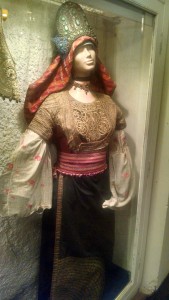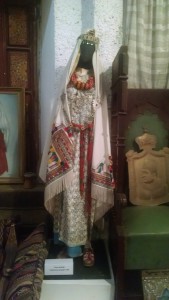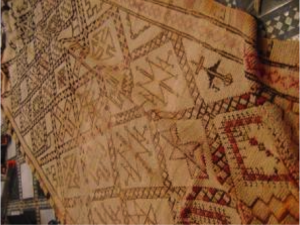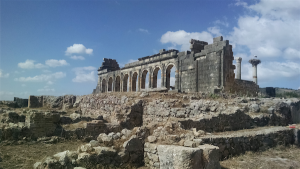Introduction
 The Amazigh, or “Free People,” are one of the most ancient political/social entities on the African continent (Dr. Mohamed Chtatou). Originally named the “Berber” (connoting “barbarism”) by early European trades-people, the Amazigh have a 4000 year history, ruling Egypt as pharaohs and building relations with Phoenician settlers across North Africa.
The Amazigh, or “Free People,” are one of the most ancient political/social entities on the African continent (Dr. Mohamed Chtatou). Originally named the “Berber” (connoting “barbarism”) by early European trades-people, the Amazigh have a 4000 year history, ruling Egypt as pharaohs and building relations with Phoenician settlers across North Africa.
With their own languages, foods, and dress and over 45 different tribal groups, these nomadic peoples rules much of Morocco well into the 11th century. They were animists, believing in the spiritual essence of non-human entities, largely until the 7th century after which Islam arrived to North African territories.
 As animists as possible Isis worshipers, some scholars note that the Amazigh likely lived within a matriarchal social structure in which females held essential roles and power within the tribe. For instance, historians have looked to a specific Amazigh tribe, the Tuareg, to note that women within these tribes have control over their marriages and economic resources which provide them a level of power; they have the right to divorce, they own their own livestock, tents, and utensils, and they have considerable influence over their households (Becker, 2006). In addition, the Tuareg have matrilineal descent.
As animists as possible Isis worshipers, some scholars note that the Amazigh likely lived within a matriarchal social structure in which females held essential roles and power within the tribe. For instance, historians have looked to a specific Amazigh tribe, the Tuareg, to note that women within these tribes have control over their marriages and economic resources which provide them a level of power; they have the right to divorce, they own their own livestock, tents, and utensils, and they have considerable influence over their households (Becker, 2006). In addition, the Tuareg have matrilineal descent.
Matrilineal descent is also encouraged through the production of language. Becker explains that the Amazigh language is one “of cultural identity, home, the family, village affiliation, intimacy, traditions, orality, and nostalgia to a remote past” and as such it “perpetuates attributes that are considered female in the Moroccan culture” (p. 209). Further, Amazigh women teach the language and are thus the guardians and carriers of their cultural identities and traditions.
Amazigh women are also the weavers and artists within their communities. Within their art they represent the power of femininity through symbology related to birthing (e.g., triangles and diamonds that represent the vulva and uterus). These women also see weaving as a process that reflects the life stages that have a beginning and end, although the end returns them back to birth.
Group Interactions Activity
Beginning in 1100 BC the Amazigh encountered the Phoenicians who were seeking new trade opportunities in Northern Africa (Dr. Mohammed Chtatou). The Phoenicians developed trade centers in Tangier, Asilah, Salé, and Essaouira, perfect zones for trade and transport, but also perfect for group interactions with the Amazigh.
By 146 BC the Romans had moved to Phoenician lands in Northern Africa with the goal of controlling these territories (Dr. Khalid Saqi). Specifically, they colonized and built an empire near Fez called Volubilis.
Nearly 900 years later the Arabs from the Middle-East had moved into Northern Morocco with the goal of expanding Islamic teachings under the Umayyad Caliphate (661-750 AD). As such, Modern Standard Arabic and Darija, the Moroccan dialect, replaced Tamazight, the Amazigh language due to the stigmas attached to this “unofficial language” (Dr. Yamina El Kirat). Also, animism was replaced by Islam for many of the Amazigh (Dr. Mohammed Chtatou).
Instructions
- Divide class in half and have the students work in groups of 2-3.
- Assign the Phoenicians to one-third of the class, the Romans to another third, and the Arabs to the last third.
- Ask students to conduct in-class (online) or library research on the Phoenicians, Romans, and Arabs at the time of their first occupation of Morocco.
- Students should find out:
- Cultural practices with regards to gender (e.g., do men and women have the same jobs within their communities? If not, how do they differ?)
- Religious ideology with regards to gender (e.g., do these groups worship certain dieties? What might this indicate about their gender ideology?)
- Structure of society with regards to gender (e.g., is it matriarchal or patriarchal? How do you know?)
- Students will present this material to the class, along with an explanation for the ways these cultural, religious, and structural practices might affect interactions with the Amazigh. Students should consider whether the Amazigh have similar values and beliefs to the Phoenicians, Romans, and Arabs and whether the goals of trade versus control versus Islamization would affect cross-cultural interactions and the Amazigh cultural traditions.
The class may consider engaging in discussion over the individual, institutional, and structural influences in gender socialization and whether it is possible for tradition to overcome these influences, especially given a non-normative traditional structure (e.g., matriarchy).
Post-discussion, Islam may be explained from the next section on the Qur’an.

